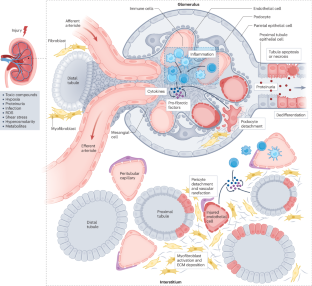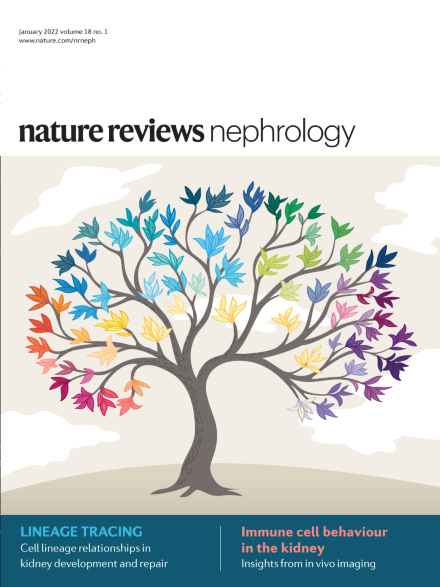处于慢性肾脏病炎症和纤维化交叉口的新陈代谢
IF 28.6
1区 医学
Q1 UROLOGY & NEPHROLOGY
引用次数: 0
摘要
慢性肾脏病(CKD)是指肾脏功能持续丧失(3 个月),其发病率越来越高(占全球人口的 10%),但治疗方法却很有限。细胞外基质异常积聚导致的纤维化是几乎所有类型的肾脏慢性重复损伤的最终共同途径,被认为是 CKD 的标志。肌成纤维细胞是产生细胞外基质的关键细胞,受损肾小管和免疫细胞之间的串扰激活了肌成纤维细胞。新的证据表明,新陈代谢的改变会影响细胞的生物能和代谢信号,是肾脏纤维化发病机制的关键因素。免疫细胞的功能与其代谢特征密切相关,肾脏细胞似乎会因损伤而发生细胞类型特异性代谢转变,所有这些都能决定慢性肾脏病的损伤和修复反应。详细了解不同肾脏细胞亚群代谢重编程的异质性对于阐明细胞类型之间的交流过程以及开发基于代谢的慢性肾脏病创新治疗策略至关重要。本文章由计算机程序翻译,如有差异,请以英文原文为准。


Metabolism at the crossroads of inflammation and fibrosis in chronic kidney disease
Chronic kidney disease (CKD), defined as persistent (>3 months) kidney functional loss, has a growing prevalence (>10% worldwide population) and limited treatment options. Fibrosis driven by the aberrant accumulation of extracellular matrix is the final common pathway of nearly all types of chronic repetitive injury in the kidney and is considered a hallmark of CKD. Myofibroblasts are key extracellular matrix-producing cells that are activated by crosstalk between damaged tubules and immune cells. Emerging evidence indicates that metabolic alterations are crucial contributors to the pathogenesis of kidney fibrosis by affecting cellular bioenergetics and metabolite signalling. Immune cell functions are intricately connected to their metabolic characteristics, and kidney cells seem to undergo cell-type-specific metabolic shifts in response to damage, all of which can determine injury and repair responses in CKD. A detailed understanding of the heterogeneity in metabolic reprogramming of different kidney cellular subsets is essential to elucidating communication processes between cell types and to enabling the development of metabolism-based innovative therapeutic strategies against CKD. Kidney fibrosis is a key pathological process in chronic kidney disease. Here, the authors examine how the metabolic reprogramming of kidney immune and non-immune cells in response to injury can promote fibrosis and consider the potential of metabolism-targeted therapies for preventing the development and progression of kidney fibrosis.
求助全文
通过发布文献求助,成功后即可免费获取论文全文。
去求助
来源期刊

Nature Reviews Nephrology
医学-泌尿学与肾脏学
CiteScore
39.00
自引率
1.20%
发文量
127
审稿时长
6-12 weeks
期刊介绍:
Nature Reviews Nephrology aims to be the premier source of reviews and commentaries for the scientific communities it serves.
It strives to publish authoritative, accessible articles.
Articles are enhanced with clearly understandable figures, tables, and other display items.
Nature Reviews Nephrology publishes Research Highlights, News & Views, Comments, Reviews, Perspectives, and Consensus Statements.
The content is relevant to nephrologists and basic science researchers.
The broad scope of the journal ensures that the work reaches the widest possible audience.
 求助内容:
求助内容: 应助结果提醒方式:
应助结果提醒方式:


